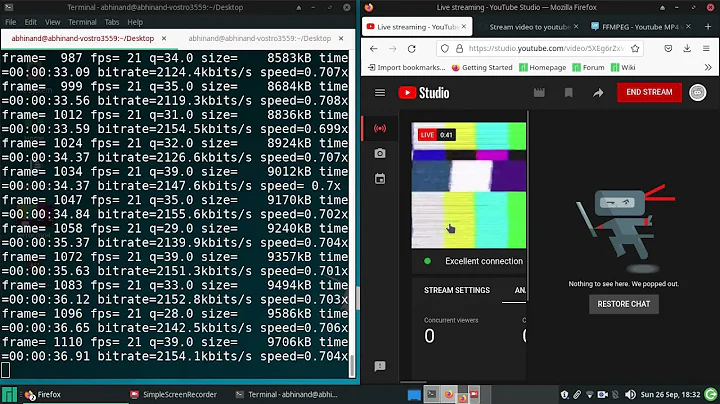How to minimize the delay in a live streaming with ffmpeg
Solution 1
I found three commands that helped me reduce the delay of live streams. The first command its very basic and straight forward, the second one it's been combined with other options which might work differently on each environment and the last command it is a hacky version that I found in the documentation It was useful at the beginning but now the first option is more stable.
1. Basic using -fflags nobuffer
This format flag reduces the latency introduced by buffering during initial input streams analysis. This command will reduce noticeable the delay and will not introduce audio glitches.
ffplay -fflags nobuffer -rtsp_transport tcp rtsp://<host>:<port>
2. Advanced -flags low_delay and other options.
We can combine the previous -fflags nobuffer format flag with other generic options and advanced options for a more elaborated command:
-
-flags low_delaythis codec generic flag will force low delay. -
-framedrop: to drop video frames if video is out of sync. Enabled by default if the master clock is not set to video. Use this option to enable frame dropping for all master clock sources -
-strict experimental, finally-strictspecifies how strictly to follow the standards and theexperimentaloption allows non standardized experimental things, experimental (unfinished/work in progress/not well tested) decoders and encoders. This option is optional and remember that experimental decoders can pose a security risk, do not use this for decoding untrusted input.
ffplay -fflags nobuffer -flags low_delay -framedrop \
-strict experimental -rtsp_transport tcp rtsp://<host>:<port>
This command might introduce some audio glitches, but rarely.
Also you can try adding:
* -avioflags direct to reduce buffering, and
* -fflags discardcorrupt to discard corrupted packets, but I think is very aggressive approach. This might break the audio-video synchronization
ffplay -fflags nobuffer -fflags discardcorrupt -flags low_delay \
-framedrop -avioflags direct -rtsp_transport tcp rtsp://<host>:<port>
3. A hacky option (found on the old documentation)
This is an debugging solution based on setting -probesize and -analyzeduration to low values to help your stream start up more quickly.
-
-probesize 32sets the probing size in bytes (i.e. the size of the data to analyze to get stream information). A higher value will enable detecting more information in case it is dispersed into the stream, but will increase latency. Must be an integer not lesser than 32. It is 5000000 by default. -
analyzeduration 0specifies how many microseconds are analyzed to probe the input. A higher value will enable detecting more accurate information, but will increase latency. It defaults to 5000000 microseconds (5 seconds). -
-sync extsets the master clock to an external source to try and stay realtime. Default is audio. The master clock is used to control audio-video synchronization. This means this options sets the audio-video synchronization to a type (i.e. type=audio/video/ext).
ffplay -probesize 32 -analyzeduration 0 -sync ext -rtsp_transport tcp rtsp://<host>:<port>
This command might introduce some audio glitches sometimes.
The -rtsp_transport can be setup as udp or tcp according to your streaming. For this example I'm using tcp.
Solution 2
FFMpeg's streaming guide has a specific section on how to reduce latency. I haven't tried all their suggestions yet. http://ffmpeg.org/trac/ffmpeg/wiki/StreamingGuide#Latency
They make a particular note about latency ffplay introduces:
By default,
ffplayintroduces a small latency of its own, Also useful ismplayerwith its-nocachefor testing latency (or-benchmark). Using the SDL out is also said to view frames with minimal latency:ffmpeg ... -f sdl -
Solution 3
Try set flags of AVFormatContext to AVFMT_FLAG_NOBUFFER | AVFMT_FLAG_FLUSH_PACKETS
AVFormatContext *ctx;
...
ctx->flags = AVFMT_FLAG_NOBUFFER | AVFMT_FLAG_FLUSH_PACKETS;
Then try to set decoder thread to 1. It seems like more thread will cause more latency.
AVCodecContext *ctx;
...
ctx->thread_count = 1;
Solution 4
Consider using the filter option -vf setpts=0. This makes all frames display as soon as possible without adding any delay for the framerate. This will allow the stream to catch up in case it falls behind, which I've found to happen if I move or resize the ffplay window. However, this could make the video look choppy if your video data is being received at an inconsistent rate.
Related videos on Youtube
Pasquale C.
Updated on March 05, 2022Comments
-
Pasquale C. over 2 years
i have a problem. I would to do a live streaming with ffmpeg from my webcam.
- I launch the ffserver and it works.
From another terminal I launch ffmpeg to stream with this command and it works:
sudo ffmpeg -re -f video4linux2 -i /dev/video0 -fflags nobuffer -an http://localhost:8090/feed1.ffmIn my configuration file I have this stream:
<Stream test.webm> Feed feed1.ffm Format webm NoAudio VideoCodec libvpx VideoSize 720x576 VideoFrameRate 25 # Video settings VideoCodec libvpx VideoSize 720x576 # Video resolution VideoFrameRate 25 # Video FPS AVOptionVideo flags +global_header # Parameters passed to encoder # (same as ffmpeg command-line parameters) AVOptionVideo cpu-used 0 AVOptionVideo qmin 10 AVOptionVideo qmax 42 #AVOptionVideo quality good PreRoll 5 StartSendOnKey VideoBitRate 400 # Video bitrate </Stream>I launch the stream with
ffplay http://192.168.1.2:8090/test.webm It works but I have a delay of 4 seconds and I would to minimize this delay because is essential for my application. Thanks
-
pogorskiy about 11 yearsYou can try to reduce the value of probesize:
ffplay -probesize 500000 http://192.168.1.2:8090/test.webm(to 500 Kb, experiment with this value, default value is 5Mb if I'm not mistaken.) -
Pasquale C. about 11 yearsok thanks. Now I have to watch the stream in a mobile browser and so I cannot use ffplay. I need some suggest to optimize the configuration file.
-
Antonio Bardazzi about 11 yearsReading ffmpeg.org/sample.html I can imagine that you can try with VideoBufferSize or reducing the GOP (it increase the bandwidth usage).
-
F Andrei over 6 yearsDid you manage to find a solution ?
-
user3473830 over 8 yearsthanks,
ffplay -probesize 32 -sync ext INPUTfrom the link did the trick for me! -
F Andrei over 6 yearsWhat latency did you achieve? I need more than 100 ms streaming latency . Is it possible ?
-
Glen Blanchard over 6 yearsI didn't measure the final delay but it looked close to live on a monitor in person with the sound which was going through a sound booth, so was good enough for me.
-
b005t3r about 4 yearsNone of this had any effect in my teting. Using SDL preview with ffmpeg (not ffplay) was the only option to reduce delay (but the lack of sound is an obvious drawback).
-
D T almost 4 yearsReducing analyzeduration and probesize from its default values did the trick for me. Could reduce 2-3 secs from stream start time.
-
 Patryk Cieszkowski almost 3 yearsI would NOT recommend attaching the
Patryk Cieszkowski almost 3 yearsI would NOT recommend attaching thenobufferflag, for a livestream. It in fact does seem to cause glitches during framedrops; causing the video either to stall for a couple of seconds, or to repeat certain fragments - this behaviour can be controlled with the-vsyncoption. Also, a VOD of such a livestream is filled with corrupted frames, and has to be re-encoded. Removing thenobufferflag solved the problem in my case. -
 Teocci almost 3 years@PatrykCieszkowski remember that this is a solution for
Teocci almost 3 years@PatrykCieszkowski remember that this is a solution forffplaynot forffmpeg. And the main idea is to reduce the delay while playing a stream. If you want to store it or transcode it with low delay probablyffmpeg -remight help but again every solution has its own pros and cons. -
 Rotem about 2 yearsI ended up with the following command:
Rotem about 2 yearsI ended up with the following command:ffplay -flags low_delay -vf setpts=0 udp://127.0.0.1:10000. Adding-vf setpts=0reduced the latency by 6 frames. The other solutions are not working (in my case). Thank you!!!






![[EN] FFmpeg RTSP to HLS live streaming without transcoding howto](https://i.ytimg.com/vi/mpZd2r5dqgM/hqdefault.jpg?sqp=-oaymwEcCOADEI4CSFXyq4qpAw4IARUAAIhCGAFwAcABBg==&rs=AOn4CLB2avKy044EO2wFj_s1SJsKARsXLg)



